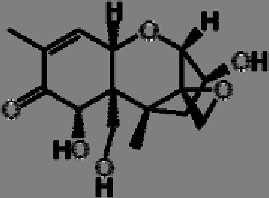Agriculture Reference
In-Depth Information
Figure 1. Chemical structure of deoxynivalenol.
Its occurrence is associated above all with
F. graminearum
and
F. culmorum
. DON is
associated with serious mycotoxicosis in humans and animals. It has cytotoxic activity
(protein synthesis inhibition, effects on DNA and RNA synthesis, mitochondrial function
inhibition, effects on cellular membranes and on correct cellular division and apoptosis) and
an immunosuppressor effect which reduce the resistance to microbial infections (Rotter et al.,
1996; Minervini et al., 2004).
According to the results of in vitro experiments with
F. graminearum
, DON is
synthesized in a range of temperatures between 5°C and over 30°C, with an optimum
production between 25°C and 30°C, depending on the a
w
. The optimum a
w
for DON
production has been reported to be near 1 (0.995) and the minimum requirement is between
0.900-0.930 (Hope et al., 2005; Ramirez et al., 2006). In field conditions, high FHB incidence
and DON contamination are not always directly correlated and contrasting cases have been
reported (Hermann et al., 1998; Höhn et al., 2002; Menniti et al., 2003; Miedaner et al.,
2003), suggesting that other complex factors such as year, site, cultivar and agronomic
technique are very important in DON contamination. However, DON contamination has been
reported to depend to a greater extend on rainfalls around heading and anthesis and on
temperatures between 10°C and 32°C around the same period (Hooker et al., 2002; Koch et
al., 2006).
DON seems to play a decisive role on the aggressiveness of
F. graminearum
and
F.
culmorum
. DON is a strong protein synthesis inhibitor and this may cause the inhibition of
defence response genes in susceptible host-cultivars, leading to a rapid increase of the disease
(Mesterhazy, 2002). Moreover, DON can induce the complete loss of chloroplast pigments at
a sub-lethal concentration (Rotter et al., 1996). It has been suggested that in the presence of
DON, plant defence mechanisms are not triggered fast enough, thereby leading to an
increased aggressiveness of the pathogen (Wagacha and Muthomi, 2007).
4.
C
ROP
M
ANAGEMENT
S
YSTEMS TO
R
EDUCE THE
O
CCURRENCE
OF
FHB
AND
DON
C
ONTAMINATION IN
W
HEAT
The accumulation of DON in the grain is intimately related to the development of the
disease in the field (McMullen et al., 1997). Therefore, the current strategy to control DON in
cereals is to manage FHB. Most practices aimed at FHB prevention are essentially crop
management practices whose goal is to reduce infection or fungal growth by toxigenic fungi
(Parry et al., 1995). Among the agricultural practices, FHB development and/or DON



Search WWH ::

Custom Search